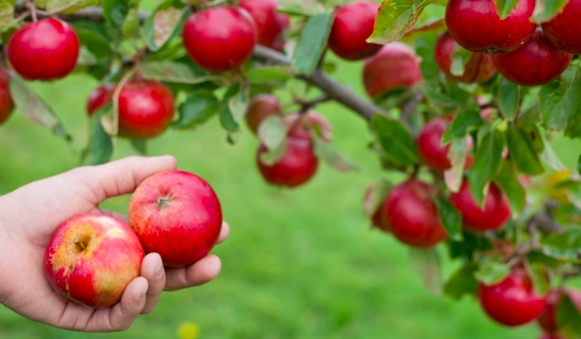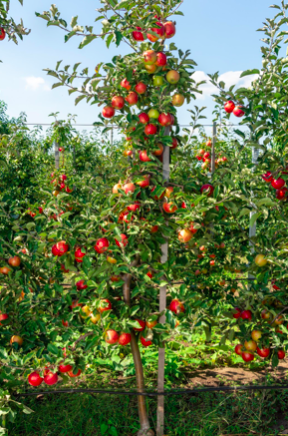
Kathleen Miller
Sustainable living, gardening, and farming is based on an understanding of ecosystems, the study of relationships between organisms and their environment. It has been defined as an integrated system of plant and animal production practices that will last over time. Having a harmonious relationship with Gaia (Mother Earth) provides food for people, enhances the natural environment upon which the community depends, makes efficient use of resources, and integrates natural cycles that sustain economic viability as well as enhances the quality of life for the community as a whole.
The fruit produced by dwarf fruit trees is just as significant as those grown on standard-sized fruit trees; the difference between standard and dwarfed trees is in their growth habits. A dwarf fruit tree grows less vigorously than a standard tree, is smaller at maturity, and begins to blossom and fruit at an earlier age following planting. The varieties that produce the hardiest root systems are not necessarily the kinds with the best fruit. The dwarf fruit tree comprises two parts, the root or rootstock, and the scion or top variety. The rootstock is chosen for the growth characteristics of the top, while the top variety produces the actual fruit. Standard fruit trees are grown in nurseries on rootstocks grown from seed. The seedlings grow for a year or two, and then better fruiting varieties are grafted or budded onto the seedlings. The next few years produce one-year whips or two- to three-year-old trees that can be sold and planted in orchards or small farms or ranches as well as backyards. Standard fruit trees, especially apples, grow large and require ample space, available in commercial orchards but not in smaller farms ranches.

A dwarf fruit tree is grown in much the same way as a standard fruit tree. It may even produce the very same kind of fruit; the difference is the rootstock. A dwarfing rootstock restricts the size of the tree, whereas a standard seedling rootstock does not. Dwarfing rootstocks are propagated in stool beds, and a particular rootstock uniformly controls the top variety’s size. It is the rootstock that determines how a tree will be dwarfed. Therefore, in buying dwarf fruit trees, it is essential to know that the rootstock is the desired dwarfing variety. Some rootstocks are significantly dwarfing, while others are semi-dwarfing. A dwarf apple or pear tree is grafted and grown on a dwarfing rootstock, which controls and limits the top variety’s growth, causing it to mature, blossom, and bear fruit earlier than a standard tree. Dwarf fruit trees are more popular with apples, pears, and sweet cherries than with other fruits because of these trees’ large size on standard rootstocks. For other fruits, dwarfing rootstocks are available and often used. However, differences in vigor, size, and fruiting are usually not nearly so significant as between dwarf and standard apple, pear, and sweet cherry trees. A dwarf fruit tree has several desirable qualities that make it a perfect fit on a small sustainable farm or in a garden. Most suburban and city home yards have enough space for a few dwarf fruit trees. They are pretty in spring bloom and productive in late summer and fall fruiting. There is no long waiting for six to eight years before your first harvest, as with the many standard trees. Dwarf fruit trees may blossom the second year after spring planting and bear fruit shortly after that, under the right growing conditions. Maintenance of dwarf fruit trees is more comfortable and fun, including fertilizing, pruning, disease, insect control, and thinning. There is no need for ladders, and pruning can be accomplished while standing on the ground. Dwarf fruit trees need full sunlight for best production. Inadequate sunlight delays the start of fruit-bearing and may reduce the amount of fruit produced.
Pollination of blossoms is necessary to form fruits. Fruit trees depend on insects to carry pollen from the anther of one flower to the stigma (pistil) of another flower to begin the process that enables the fruit to develop. Some varieties are self-fruiting, which means that the blossoms of such a variety can be fertilized by the pollen of the same variety. Self-unfruitful varieties must be fertilized by the pollen of different varieties. You will not need to worry about the pollination of blossoms as long as you plant two or more varieties of each kind of dwarf fruit trees. Keep in mind that when you choose different varieties for cross-pollination, they should come into flower simultaneously to be successful. Honey bees are efficient at pollinating. Even if you don’t keep bees on your property, many wild bees and insects will provide your dwarf fruit trees with blossom pollination. When purchasing your dwarf fruit trees, it is important that you buy certified disease-resistant varieties. Create a dwarf orchard to complement your sustainable farm, garden, or ranch and provide fresh fruit for you, your friends, and your family for years to come.
Support Northern Colorado Journalism
Show your support for North Forty News by helping us produce more content. It's a kind and simple gesture that will help us continue to bring more content to you.
BONUS - Donors get a link in their receipt to sign up for our once-per-week instant text messaging alert. Get your e-copy of North Forty News the moment it is released!
Click to Donate
